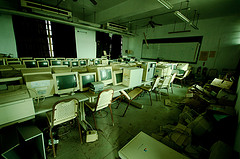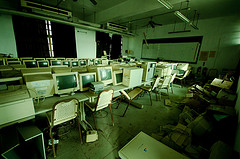Concept of scarcity and branches of study within economics

Scarcity, a concept we already implicitly discussed in the introduction to this tutorial, refers to the tension between our limited resources and our unlimited wants and needs. For an individual, resources include time, money and skill. For a country, limited resources include natural resources, capital, labour force and technology. Because all of our resources are limited in comparison to all of our wants and needs, individuals and nations have to make decisions regarding what goods and services they can buy and which ones they must forgo. For example, if you choose to buy one DVD as opposed to two video tapes, you must give up owning a second movie of inferior technology in exchange for the higher quality of the one DVD. Of course, each individual and nation will have different values, but by having different levels of resources, people and nations each form some of these values as a result of the particular scarcities with which they are faced. So, because of scarcity, people and economies must make decisions over how to allocate their resources. Economics, in turn, aims to study why we make these decisions and how we allocate our resources most efficiently.
Macro and Microeconomics Macro and microeconomics are the two vantage points from which the economy is observed. Macroeconomics looks at the total output of a nation and the way the nation allocates its limited resources of land, labour and capital in an attempt the resource for investing and personal finance education. to maximize production levels and promote trade and growth for future generations. After observing the society as a whole, Adam Smith noted that there was an “invisible hand” turning the wheels of the economy: a market force that keeps the economy functioning. Microeconomics looks into similar issues, but on the level of the individual people and firms within the economy. It tends to be more scientific in its approach, and studies the parts that make up the whole economy. Analysing certain aspects of human behaviour, microeconomics shows us how individuals and firms respond to changes in price and why they demand what they do at particular price levels.
Micro and macroeconomics are intertwined; as economists gain understanding of certain phenomena, they can help nations and individuals make more informed decisions when allocating resources. The systems by which nations allocate their resources can be placed on a spectrum where the command economy is on the one end and the market economy is on the other. The market economy advocates forces within a competitive market, which constitute the “invisible hand”, to determine how resources should be allocated. The command economic system relies on the government to decide how the country’s resources would best be allocated. In both systems, however, scarcity and unlimited wants force governments and individuals to decide how best to manage resources and allocate them in the most efficient way possible. Nevertheless, there are always limits to what the economy and government can do.
For assistance with your Economics Homework Help you can visit classof1.com
Classof1.com is open 24/7. You can call us at 1-877-252-7763 or drop an email to learning@classof1.com
